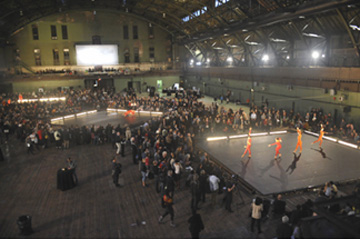Merce Cunningham: A Week at a Time
By DAWN LILLE
ART TIMES online Nov/Dec 2009
 Merce Cunningham Dance Company (Photo: Stephanie Berger) |
Sometimes the New York City dance world has so much in it one is overwhelmed. In the course of a week in late October it was possible to see the Merce Cunningham memorial at the Park Avenue Armory, something called ZEE; A Rigorous Mindscape; A Hallucinatory Architecture of Light; A Dream Machine, the third season of Morphosis/The Christopher Wheeldon Company and to attend a dancing and spoken memorial for Francis Mason, the writer and critic – all among dozens of other offerings.
Historically, the most important of these was probably what was termed “Events in Honor of Merce.” Cunningham (April 16, 1919-July 26, 2009), considered by many to be the most significant and influential of 20th century modern dance choreographers, was remembered by five hours of free dance and music in the vast inside space of the amazing armory structure. There were three square performance areas arranged on a diagonal, each defined on all sides by low stage lights and surrounded by chairs and benches. There was still plenty of room for walking around, venturing from performance to performance (perfectly scheduled in true Cunningham fashion, there was often more than one thing happening at a time), meeting colleagues and encountering fifty years of Cunningham alumni, many of whom danced excerpts from older works.
The current company danced at 4:30 and at 7:30 and former company members danced excerpts from many different periods all through the afternoon and early evening.. The sound environments were created by the musicians, who were placed upstairs on the balcony with their equipment, and included many of the composers who had written for Merce. There were also recordings of John Cage. David Vaughan, the company archivist and possessor of an unforgettable voice, read some of Cage’s pieces.
Two alumni, who danced a duet, were heard talking beforehand and one said, “I don’t know if I can walk out there and move without crying.” What was so amazing was that the memory of steps, timing and space seemed to remain in the bodies of these former dancers, a testament to the philosophy of the man being honored.
Cunningham did not expect to live forever and was very careful to arrange for his legacy beforehand. The current company will remain in existence for two years, making a world tour. At the end of this period it will disband. The works themselves will be preserved so that they can be studied and performed in the future and everything will be transferred to a trust in an effort to maintain this artistic legacy.
The environment of the Cunningham memorial was unique both physically and in a spiritual/creative sense. ZEE, conceived by Kurt Hentschlager and presented by FuturePerfect, a performance, media and technology initiative, was also an environment. Stroboscopic in nature, it involved a dense fog and flickering lights, both of which obliterated the participants’ normal mode of visual perception. Along with an aural soundscape, it allowed the willing members of the group to think through new modes of perception – a form of exploration that interested Cunningham as well.
Christopher Wheeldon is a star choreographer throughout the world. His maintenance of his own company – albeit it part-time and made up of dancers from other companies and countries – is a risk he says he is willing to take in order to explore further the possibilities of the art of ballet. His pre-performance curtain speech was open, homey and tended to make the audience feel part of this group, which was shown in videos as rehearsing, living and cooking together.
For this engagement they established a working relationship with the Philharmonic Orchestra of the Americas, founded and conducted by the young Mexican Alondra De La Parre. Their sounds, their youth and their desire to work with young composers are all refreshing.
The program began with Commedia, choreographed in 2008 by Wheeldon to Igor Stravinsky’s music and using nine of the sixteen dancers in the company. It is an open, flowing work that makes use of the personalities of the standard Commedia dell’Arte characters and showed the skills of the Morphosis performers, but is not one of his outstanding dances.
Leaving Songs is a commissioned piece by Tim Harbour, an Australian choreographer who is relatively unknown in this country. His approach seems to mirror Wheeldon’s in looking for and expanding the possibilities in classical ballet. Well rehearsed and performed, it was nice to watch, but did not appear particularly noteworthy.
Bolero, fourth on the program, choreographed by Alexei Ratmansky to Ravel’s well known score, is an amazing piece of choreography, considering that the music could almost be considered a cliché by now. But Ratmansky, who created this work in 2001, used his three men and three women as a resilient group against the score, interpolating duets and solos. Wendy Whelan of the New York City Ballet, looked better and happier than I have ever seen her, except in some Wheeldon ballets, in this, by far the best work on the program.
Francis Mason would have found something positive and encouraging to say about all these offerings. Editor of Ballet Review, WQXR critic, author of several books, active supporter of both Balanchine and Graham, advocate for and encourager of all kinds of art, but especially dance, he welcomed any new approach or attempt at one.
Email your response to this and other essays in ART TIMES info@ArtTimesJournal.com
